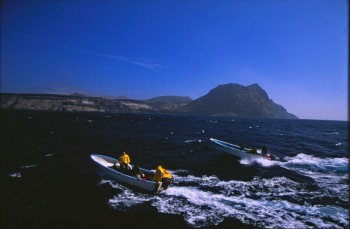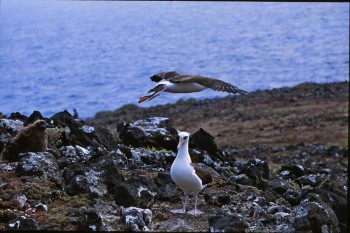
Isla Guadalupe lies 240 km off Mexico’s Baja Peninsula. The 244-km² island has a small human population that mainly subsists on fishing. During the 1983/84 winter breeding season Near Threatened Laysan Albatrosses Phoebastria immutabilis bred on Isla Guadalupe for the first time in recorded history. The population had reached 45 pairs in 1991/92, 120-190 pairs in 1999-2001 (which included small colonies of <50 nests each on nearby Islote Zapato and Islote Negro), 337 pairs in 2005 and 340 pairs in 2007. In 2009 a census yielded 457 pairs, showing that the Laysans of Guadalupe are steadily on the increase, thought due mainly to immigration.

The main colony on Isla Guadalupe supported c. 200 pairs in 2003
The colony is situated on the inland plateau, about 100 m above sea level, with sheer cliffs dropping down to the coastal plain where the naval garrison and fishing village are situated

A smaller, satellite colony on one of the small islets close to the main island, which had just over 50 pairs/active nests in early 2003

A Laysan Albatross pair in the main colony on Guadalupe display together
All photographs by Ross Wanless
Isla Guadalupe and its surrounding waters are a Biosphere Reserve declared in April 2005 but it suffers from introduced predators, although the introduced domestic goats and feral dogs have now been eradicated. In 2002 a hunter from Grupo de Ecología y Conservación de Islas (GECI), Mexico’s island conservation organisation, trapped a feral cat in the colony that had learnt to kill adult albatrosses. The next year albatross researcher Bill Henry reported “[w]hen I began my research in 2003, I arrived to a sad and gory scene. Feral cats had killed 60 breeding adult albatrosses. Their remains littered the colony and were scattered about with abandoned dead eggs. In the short term our [GECI] efforts have stopped the killing and we have not witnessed any new deaths since. However hundreds of cats remain on the island, posing a constant threat to the albatrosses and the other birds.” Research was undertaken on the island by GECI in 2009 towards their eventual eradication.
Click here for a recent Guadalupe restoration project report in Spanish.
Selected References:
Aguirre-Muñoz, A., Samaniego-Herrera, A., Luna-Mendoza, L., Ortiz-Alcaraz, A., Rodríguez-Malagón, M., Méndez-Sánchez, F., Félix-Lizárraga M., Hernández-Montoya, J.C., González-Gómez, R., Torres-García, F., Barredo-Barberena, J.M. & Latofski-Robles, M. 2011. Island restoration in Mexico: ecological outcomes after systematic eradications of invasive mammals. In: Veitch, C.R., Clout, M.N. & Towns, D.R. (Eds). Island Invasives: Eradication and Management. Proceedings of the International Conference on Island Invasives. Gland: IUCN & Auckland: Centre for Biodiversity & Biosecurity. pp. 250-258.
Aguirre-Muñoz, A., Samaniego-Herrera, A., Luna-Mendoza, L., Ortiz-Alcaraz, A., Rodríguez-Malagón, M., Méndez-Sánchez, F., Félix-Lizárraga, Méndez-Sánchez, F., González-Gómez, R., Torres-García, F., Hernández-Montoya, J.C., Barredo-Barberena, J.M. & Latofski-Robles, M 2011. Eradications of invasive mammals on islands in Mexico: the roles of history and the collaboration between government agencies, local communities and a non-government organisation. In:Veitch, C.R., Clout, M.N. & Towns, D.R. (Eds). Island Invasives: Eradication and Management. Proceedings of the International Conference on Island Invasives. Gland: IUCN & Auckland: Centre for Biodiversity & Biosecurity. pp. 386-394.
Dunlap, E. 1988. Laysan Albatrosses nesting Guadalupe Island, Mexico. American Birds 42: 180-181.
Gallo-Reynoso, J.P. & Figueroa-Carranza, A.L. 1996. The breeding colony of Laysan Albatrosses on Isla de Guadalupe, Mexico. Western Birds 27: 70-76.
Henry, R.W. & Aguirre, A. 2007. Tale of the Guadalupe Laysan Albatross. Pronatura.
Luna-Mendoza, L., Barredo-Barberena, J.M., Hernández-Montoya, J.C., Aguirre-Muñoz, A., Méndez-Sánchez, F.A., Ortiz-Alcaraz, A. & Félix-Lizárraga, M. 2011. Planning for the eradication of feral cats on Guadalupe Island, México: home range, diet, and bait acceptance. In: Veitch, C.R., Clout, M.N. & Towns, D.R. (Eds). Island Invasives: Eradication and Management. Proceedings of the International Conference on Island Invasives. Gland: IUCN & Auckland: Centre for Biodiversity & Biosecurity. pp. 192-197.
Pitman, R.L., Walker, W.A., Everett, W.T. & Gallo-Reynoso, J.P. 2004. Population status, foods and foraging of Laysan Albatrosses Phoebastria immutabilis nesting on Guadalupe Island, Mexico. Marine Ornithology 32: 159-165.
John Cooper, ACAP Information Officer & Ross Wanless, BirdLife Global Seabird Programme, 14 June 2013

 English
English  Français
Français  Español
Español